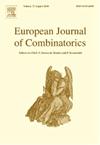Tight bound on the minimum degree to guarantee graphs forbidding some odd cycles to be bipartite
IF 0.9
3区 数学
Q1 MATHEMATICS
引用次数: 0
Abstract
Erdős and Simonovits asked the following question: For an integer and a family of non-bipartite graphs , determine the infimum of such that any -free -vertex graph with minimum degree at least has chromatic number at most . We answer this question for and any family consisting of odd cycles. Let be a family of odd cycles in which is the shortest odd cycle not in and is the longest odd cycle in , we show that if is an -vertex -free graph with and , then is bipartite. Moreover, this bound on the minimum degree is tight.
保证禁止某些奇数循环的图为两部分图的最小度数的严格约束
Erdős和Simonovits提出了以下问题:对于整数r≥2和非二部图族H,确定α的最小值,使得任何最小度至少为αn的无H n顶点图的色数最多为r。我们回答了r=2和任何由奇环组成的族的这个问题。设C是奇环族,其中C2 l +1是不在C内最短的奇环,C2k+1是在C内最长的奇环,我们证明了如果G是n≥1000k8且δ(G)>max{n/(2(2 r +1)),2n/(2k+3)}的n顶点无C图,则G是二部的。而且,这个最小度的界是紧的。
本文章由计算机程序翻译,如有差异,请以英文原文为准。
求助全文
约1分钟内获得全文
求助全文
来源期刊
CiteScore
2.10
自引率
10.00%
发文量
124
审稿时长
4-8 weeks
期刊介绍:
The European Journal of Combinatorics is a high standard, international, bimonthly journal of pure mathematics, specializing in theories arising from combinatorial problems. The journal is primarily open to papers dealing with mathematical structures within combinatorics and/or establishing direct links between combinatorics and other branches of mathematics and the theories of computing. The journal includes full-length research papers on important topics.

 求助内容:
求助内容: 应助结果提醒方式:
应助结果提醒方式:


